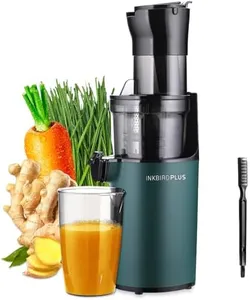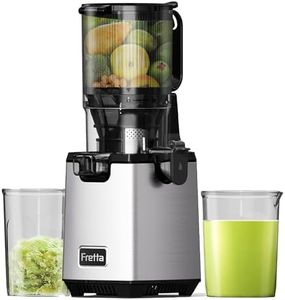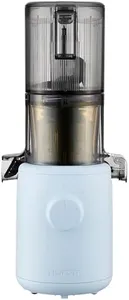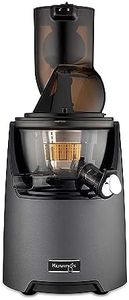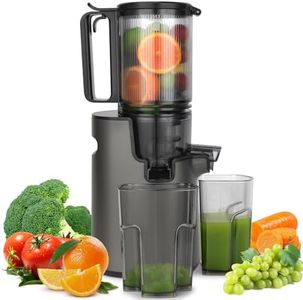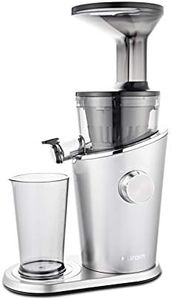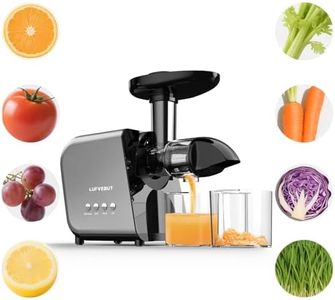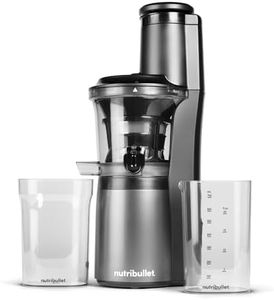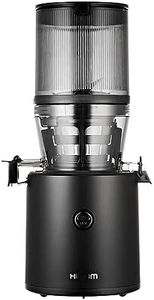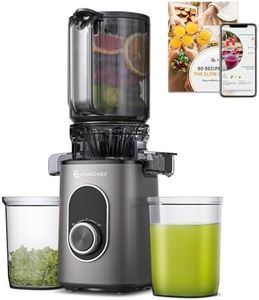We Use CookiesWe use cookies to enhance the security, performance,
functionality and for analytical and promotional activities. By continuing to browse this site you
are agreeing to our privacy policy
10 Best Masticating Juicers
From leading brands and best sellers available on the web.Buying Guide for the Best Masticating Juicers
Selecting a masticating juicer can seem complex, but with the right information, you'll be able to choose a model that fits your needs and lifestyle. Masticating juicers, often called slow juicers, use an auger to crush and press fruits and vegetables to extract juice. This method is known for yielding high-quality juice, preserving nutrients, and handling a variety of produce, from leafy greens to hard roots. Consider how often you’ll juice, what types of ingredients you enjoy, and how much time you want to spend on preparation and cleaning. Evaluating features that matter most to your routine will help you find the best juicer for you.Juicing Speed (RPM)Juicing speed, measured in revolutions per minute (RPM), indicates how quickly the juicer's auger turns. Lower RPMs, typically between 40 and 80, mean slower juicing, which generates less heat and preserves more nutrients. Higher RPMs up to 120 may work faster but can lead to more oxidation, affecting juice quality. If your priority is the best nutrition and juice longevity, go for a lower RPM. On the other hand, if you value quicker juicing and don’t mind a slight nutrient loss, a moderate RPM may be suitable.
Feed Chute SizeThe feed chute size determines how much prep work you need to do. A wide feed chute lets you insert bigger pieces or even whole fruits, while a narrow chute requires you to cut produce into smaller chunks. Wide chutes save time, which can be helpful if you juice often or in large batches. On the other hand, narrower chutes can be safer, especially if kids might help. Consider whether you want to minimize cutting or don’t mind spending a little more time prepping.
Juice YieldJuice yield reflects how much juice the machine extracts from produce. Higher yield means more juice per fruit or vegetable and drier pulp left behind. Juicers with high yield are efficient, especially if you plan to juice leafy greens or harder veggies. If you want to make the most of your ingredients, look for reviews or specs that highlight high extraction rates.
Ease of CleaningEase of cleaning can make a huge difference in how often you use your juicer. Some models have fewer parts or dishwasher-safe components, while others require careful, manual cleaning. If convenience is important for your routine, check user experiences or product documentation for cleaning details. Easy-to-clean juicers encourage frequent use, while complicated designs might lead to your machine collecting dust.
Noise LevelNoise level refers to how loud the juicer operates. Masticating juicers are generally quieter than centrifugal models, but there can still be differences. Quieter machines are important if you’ll juice early in the morning, live in shared spaces, or are sensitive to noise. If peace and quiet matter, consider models known for low decibel operation.
VersatilityVersatility reflects a machine's ability to process a variety of ingredients beyond basic fruits and vegetables, such as leafy greens, wheatgrass, nuts (for milk or butter), or even pasta dough. Some masticating juicers come with additional attachments for these purposes. If you only plan to make juice, a basic model will suffice. But if you want more options in the kitchen, look for versatile features.
Build MaterialBuild material affects the durability and longevity of your juicer. Parts made from high-quality plastic, stainless steel, or BPA-free materials usually last longer and resist staining. For heavy or daily use, it’s worth considering better materials for longer life and easier maintenance. Think about how hard you’ll run your juicer to decide what level of build quality fits your needs.
